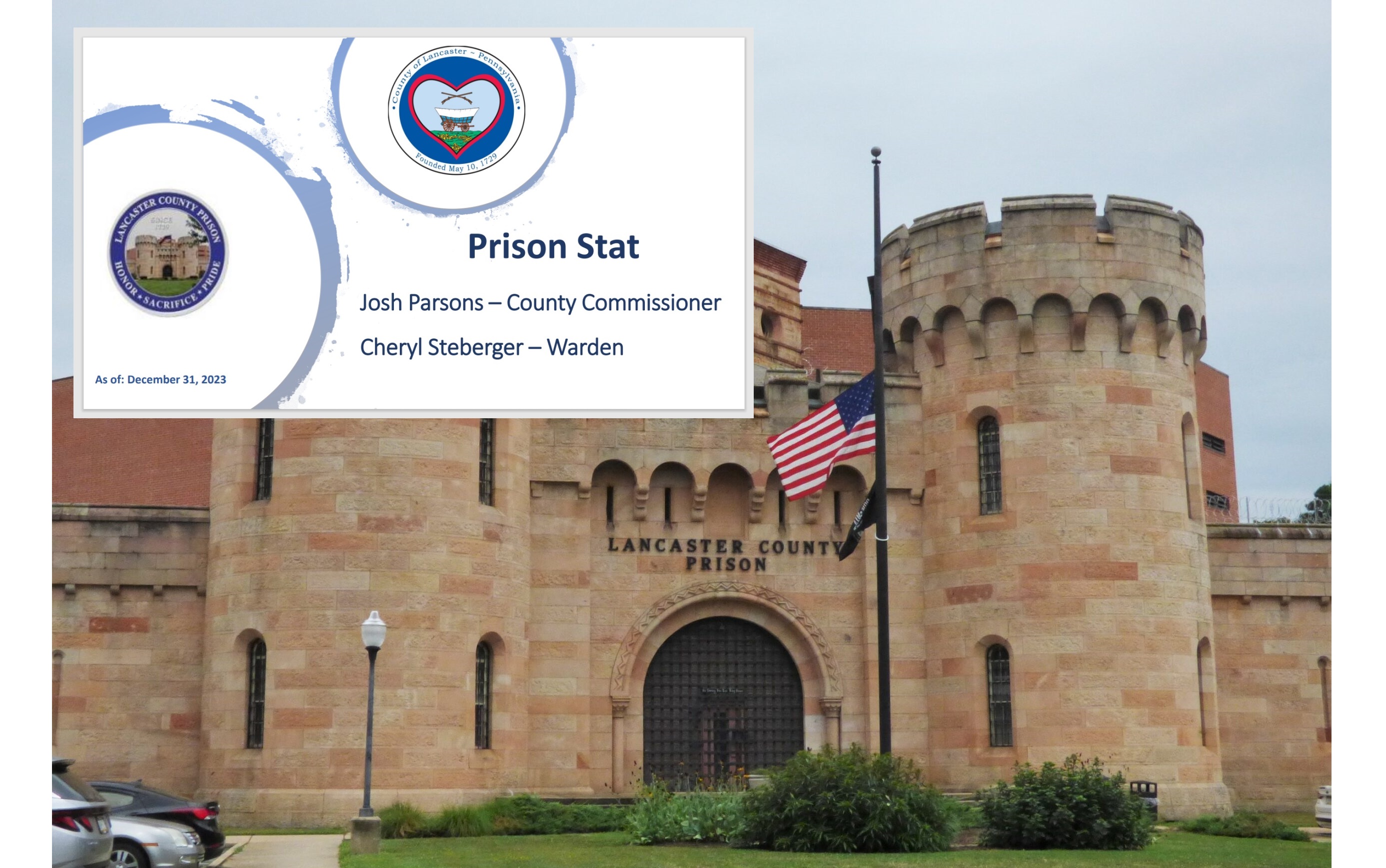The Lancaster County Prison is housing more inmates, and more of them have serious mental illnesses, but it is meeting the challenge thanks to enhanced training and the easing of its staffing shortage.
Those were some of the takeaways from the county’s Feb. 13 PrisonStat meeting. PrisonStat provides for the disclosure and public discussion of a wide range of County Prison metrics, with the goal of improving performance through transparency and accountability. The meeting reviewed the 2023 data report, available here (PDF).
Commissioner Josh Parsons, who headed PrisonStat’s creation in 2016, said he’s unaware of an initiative like it at any other county prison in Pennsylvania. “It has paid off,” he said at the Feb. 15 Prison Board meeting, contributing materially to the prison administration’s ongoing efforts to prevent suicides, interdict contraband and address other areas of concern.
He and Warden Cheryl Steberger presided at the Feb. 13 discussion. Here are five takeaways:
1. Intakes and mental illness
There’s been a sharp increase in the number of individuals entering County Prison who have been diagnosed with a serious mental illnesses (SMI). The prison averaged 76 SMI inmates in 2023, versus 54 in 2021, an increase of 40% in two years. In November 2023, the SMI headcount peaked at 96, before dropping to 73 in December.
The increase reflects trends in the broader community, Deputy Warden Joe Shiffer said: Nationwide, mental health problems have surged since the pandemic and Lancaster County is not immune.
The increase has overwhelmed mental hospitals, which is leading to lengthy delays when individuals are adjudicated incompetent to stand trial and inpatient treatment is ordered, Reentry Services Coordinator Christina Fluegel said: The process previously took a couple of months but now stretches six months or more.
The PrisonStat meeting didn’t directly address overall prison population numbers, but it is a topic reviewed intensively at the Prison Board’s monthly meetings. While headcounts remain far lower than their peaks in the early 2010s, they are creeping upward. Average annual population was 764 in 2023, versus 756 in 2022 and 699 in 2021, a 9.3% increase in two years.
2. Use-of-force, assaults and suicides
The increases in prison population and mental illness have not led to corresponding increases in use of force — an outcome Warden Steberger credited to effective treatment, increased staffing and better training.
Prison staff used force 173 times in 2023, up 5.5% from 2022 but down 13% from 2021. The majority of instances (92) involved pepper spray; the prison also tracks the use of stun guns and electronic immobilizer devices (13 deployments) and restraint chairs (25 deployments). Those modalities account for 130 instances in 2023; the remaining 43 involved body-to-body restraint or the application of handcuffs or shackles, Investigator Justin Hackler said.

There were no instances involving deadly force or canines, Steberger said.
The relatively low numbers are especially notable given last year’s legionella crisis, Hackler said. Inmates had to be moved in and out of blocks en masse to allow decontamination, and large numbers had to be staged in the gymnasium, he and Steberger said, but order was maintained without the need for extraordinary measures.
The assault data presented for 2023 was sharply lower than previous years, but the numbers aren’t “apples to apples” due to a change in reporting: Until this year, the prison reported all assaults, but starting in 2023 it is using the state’s threshold: Assaults that result in an injury or a criminal charge. That will be the standard from now on, Steberger said, though the prison continues to track less serious incidents, too.
Arla Brown, director of prison administration, noted that one inmate alone was responsible for four staff injuries. That’s helpful to know, Commissioner Alice Yoder said, recommending that future PrisonStat reports show not only assaults, but how many individuals committed them.
As for suicides, there were six attempts in 2023, all of which were survived. The prison has now gone two years without a completed suicide, Steberger said.
The prison has been working hard on suicide prevention, Parsons said, and it needs to keep doing so. It is, Deputy Warden Joe Shiffer said: Among other things, prison staff are proactively assessing inmates whenever their circumstances suggest there might be reason for concern.
Eyeing the future
The new county correctional facility being planned in Lancaster Township came up several times during Feb. 13’s PrisonStat discussion.
County officials and advocacy groups alike have high hopes that the new complex will remedy the acute deficiencies found at the existing County Prison, which is badly outdated.
For example, take assaults and use-of-force incidents. They increase in summer, which is unsurprising, given that high heat shortens people’s tempers and the County Prison isn’t air conditioned. The new site will be, and hopefully that will bring summer incidents down, Commissioner Josh Parsons said.
Other potential benefits:
- Improved layout and workflow within a trauma-informed design framework, all of which is hoped will enhance security and efficiency;
- More suitable facilities for the increasing number of inmates with serious mental health issues. That’s a priority the planning team is thinking about a lot, Warden Cheryl Steberger said;
- More and better space for mental health treatment, drug treatment, education and reentry programming, all of which are hoped to reduce recidivism;
- Improved staff retention and morale, thanks to a better work environment and improved staff amenities.
3. Contraband
The prison works very hard to block any and all opportunities to smuggle contraband, Steberger said. In 2023, it confiscated 20 contraband items, the majority discovered during intake.
Four confiscated items were weapons, including two shanks constructed out of metal removed from tablets. Administrators addressed that problem by revamping the sign-out system so that tablets are always assigned to individual inmates, who are responsible for them.
There were seven instances of inmates diverting medications received in the Medicated Assisted Treatment program for substance use disorder. Staff interviewed the perpetrators and consulted with other prisons to shore up MAT procedures and prevent further diversions, Hackler and Shiffer said.
In the past, contraband at the prison was a huge problem; getting it under control is a major success, and likely has saved lives, Parsons said. Asked by Commissioner Alice Yoder if effective interdiction contributes to fewer use-of-force incidents, Hackler said it probably does, as contraband is something inmates fight over.
4. Staffing and overtime
The County Prison experienced a major staffing crisis during the pandemic, which the county addressed with a pay raise and a recruitment push. The PrisonStat numbers show the difference.
There are 43 correctional officer vacancies and 50 vacancies overall, down from about 100 during the pandemic. Total overtime hours are down 12% over 2022 and mandatory overtime is down 57%.
5. Recidivism
The prison’s “New Beginnings” program seeks to prepare participants for reentry, so they don’t reoffend. To date, 60 individuals have reached the three-year post-release mark; of those, 65% have reoffended, about the same as Pennsylvania’s statewide average.
Asked about the reasons driving recidivism, Fluegel admitted the prison hasn’t been asking about or tracking them. However, it could try doing so during intake, Steberger said. If necessary, another PrisonStat metric could be dropped to make room for that one, Parsons said.
Fluegel noted that New Beginnings is one reentry program of many; going forward, the prison wants to provide statistics reflective of all of them. She said the switchover to a new computer system, expected in late summer or early fall, should make it easier to retrieve and compile data.
The variety of programs and their target populations can make it difficult to compile statistics that are “apples to apples,” Fluegel said. Parsons agreed: The prison should figure out which statistics best reflect what it has influence over, he said.
“Our ultimate measure is recidivism,” he said. “We want less people to come back.”










